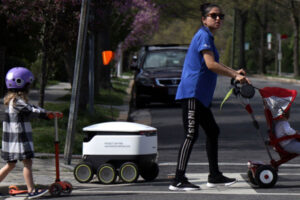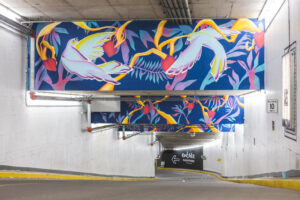By Kent Rathwell
A story brought to you by the Founder of Sun Country – Winner of the World’s Best Automotive Solution of the Year and Canada’s Greenest Manufacturer of the Year Award, for electrifying the entire Trans-Canada Highway in 2012 with EV charging stations and virtually all of Canada’s highways in 2013, making Canada the world leader in EV infrastructure many times over!
Airports that offer complimentary EV charging make more money by encouraging EV driving customers to park their EVs while they travel rather than having friends, family or car hires bring them to and from the airport.
Based on actual facts and experiences, this story will take you through two scenarios that demonstrate how this can be the case for your local airport.
Imagine this…
It’s winter holidays and I’m relaxing on the beach with my family, stress-free and focused on quality family time with the kids. It’s warm and I’m away from the cold Canadian winter (which I love by the way) … but it is so nice to have a warm holiday!
While talking to another Canadian I just met at the beach bar, they say a cold snap just hit back home and how lucky we are to be in the warmth, by the sea, with no cares in the world!
This is where this story goes one of two ways. One of happiness, confidence, thankfulness, and peace for the whole family or … one of fear, frustration, hopelessness, and anger.
The airport where I parked my EV will now determine the rest of my holiday, my family’s happiness, our stress, our memories and if we ever pay to park at that airport again!
The one story will encourage us to tell all our EV…
By Adamo Donatucci
The last mile of any journey is often the most fraught.
This phenomenon was first conceptualized by utilities and communications providers that were able to, for example, deliver their products to a neighbourhood easily but then experienced challenges connecting individual homes.
Likewise, logistics companies can easily coordinate delivering many goods to a central depot, but often experience difficulty finalizing the delivery to individual homes because a signature is required but the homeowner isn’t available. It’s also the most expensive and time-consuming part of the logistics lifecycle, so there’s a great deal of interest in finding more efficient solutions.
Similar matters occur in the realm of parking: getting to a concert venue downtown is easy enough but finding an affordable parking space nearby can be consuming.
As an increasing proportion of the world’s population lives in urban centres and those centres become increasingly dense, we can expect these dilemmas to worsen over time. To address these matters as they arise, companies are leveraging people’s interconnectedness with technology to develop solutions that are flexible and sustainable.
Last-Mile Parking Technology
Ninety-eight percent of parking transactions today leverage technology at some point in the transaction process. This includes anything from a driver visiting a pay-on-foot kiosk on their way back to their vehicle before leaving a parking garage, looking online to compare rates near their intended destination, to scanning a QR code posted near a parking meter to pay for a session without touching a machine.
In the context of the parking industry, last-mile technology includes everything that makes the driver’s life simpler and more convenient and lets them get to their destination more quickly and efficiently. In practical terms, this means reserved parking with ancillary services like electric vehicle (EV) charging and detailing, or apps that locate…
By Nicole Chinea, CAPP & Benjamin Sands, CPP
The Covid-19 crisis has been devastating to most public and private parking operations. The pandemic-driven shutdowns, school closures, and corporate moves to remote work, coupled with curtailing of business travel, reduced parking demand by as much as 90% across not only Canada, but the entire global community. The crisis didn’t simply decimate parking revenues; it wrought societal changes that may be with us for years to come.
While we are starting to embrace our “new normal” and see an upswing compared to where we were a year ago, it still may take many months, or even years, for parking demand return to pre-Covid peaks. What are parking owners and operators to do? How can they respond to, and take advantage of, changing market conditions if people require less parking? How can they adapt their parking facilities and operations to be as productive as possible during this period, and prepare for whatever future demand holds?
Flexibility is Key
For many parking operations, the answer is found in operational optimization, resiliency planning, and designed flexibility. Operational Optimization is essentially the efficiency of doing more with less. Parking operations are likely to be working with dramatically fewer parkers and staff, and less revenue — at least for the foreseeable future.
One option is scaling the operation to meet current needs. If demand has diminished by 80%, there is no need to maintain and keep available 100% of the inventory during this period. Where possible, parking operations, process, and spaces available for use should be consolidated to minimize expense and liability (e.g., closing satellite locations to consolidate parking use to central locations, closing vehicle access to unused levels, automating cashiered operations, changing operating process, etc.).
Alternative approaches to facility use…
By Dave Rich and John Abraam
Canada’s automobile future is electric. In recent months both General Motors and Ford have announced their intention to begin transitioning to electric cars and trucks, with GM aiming to produce only EVs by 2035 and Ford and Stellantis (formerly Fiat Chrysler) setting a goal of 40% of their vehicles being electric by 2030. Other automakers are even more ambitious. For instance, Volvo plans to go all-electric by 2030.
The anticipated evolution of Ford and GM cars and trucks from gas power to electric will have enormous implications. Of course, the ultimate goal is to be more sustainable. Eliminating exhaust from millions of cars and trucks could have enormous implications for the environment and the health of Canadians.
The transition won’t come without challenges. The change-over will have an enormous impact on individuals and businesses alike. For instance, it takes longer to recharge an electric vehicle than a gas one; how will that impact people who must drive distances beyond the battery’s range? How will Canada develop sufficient recharging infrastructure? What will happen to gas stations; will they become “juice bars”? These issues will sort themselves out over time, but the answers won’t come without hurdles.
Parking, in particular, will feel the impact. Parking facilities will be the most important charging location, aside from the driver’s home. After all, where else do people leave their vehicles for long enough periods of time to fully charge an electric car or truck?
And parking owners aren’t ready.
Most owners of parkades and complexes with parking assets don’t have the infrastructure in place to provide widespread EV charging. Even those that do offer charging usually only have a handful of EV charging stations on hand. That may be sufficient today, when a relatively small percentage…
By Chris Scheppmann
When we visualize artificial intelligence (AI), we often think of robots learning how to think, so they can perform human tasks. And of course, those of us who are science fiction fans probably envision apocalyptic acts committed by hordes of out-of-control robots. Thankfully, the reality is much safer and more useful than robots learning how to kick a soccer ball. This is particularly true when it comes to parking.
One of the most important recent breakthroughs in parking guidance technology is Machine Learning. Through Machine Learning, parking guidance has become highly accurate and useful, both for helping manage parking inventory and when it comes to providing parking operations with business intelligence to make better informed decisions. But, to understand the role that Machine Learning is playing in parking guidance, it is first necessary to understanding what Machine Learning is.
What is Machine Learning?
Machine Learning is a type of AI. Equipment paired with Machine Learning is able to modify itself when exposed to more data. It is dynamic and does not require human programmers or designers to manually make changes and the Machine Learning models can continually improve its understanding of an environment where it is being used.
As Arthur Samuel, a pioneer of the field stated in 1959, Machine Learning “gives computers the ability to learn without being explicitly programmed.” As an example, Machine Learning is like a child who is born without having any knowledge and adjusts (knowledge improves) its understanding of the world in response to experience (receives new data). As that baby continues to be exposed to similar and new experiences, its ability to make connections and decisions improves. Over time, a child can differentiate between a spotted dog and a cow or a brown-haired dog and a…
By Bern Grush, Harmonize Mobility Inc., Toronto
It is expected that in some places and times service robots will be permitted to operate on public sidewalks, pathways, bicycle paths, and roadways. Will their introduction impact central business districts in our cities? Could they impact parking revenue? Will they create a need for new forms of public, shared-space monetization related to their use?
No one is surprised that we could expect some changes in the parking industry due to AVs, especially autonomous taxis for ridehailing. Ride hailing has already shown it can negatively impact parking demand.1 Surely, if the robotaxi arrives as promised — even cheaper and more reliable than ride-hailing — then parking demand would contract accordingly. But the continuous failure of promises from the autonomous passenger-vehicle industry since 2015 says this scenario is still on the far horizon — if anywhere.
Sidewalk-scaled delivery robots, also called personal delivery devices (PDDs), are far more likely to be in pervasive service in our cities and suburbs sooner than robotaxis will provide regular passenger service. This is because the multiple barriers to deployment of these sidewalk robots are more easily surmounted than the equivalent deployment barriers for the robotaxi.2
The single largest barrier to the robotaxi to date is that they are unable to go anywhere at any meaningful scale without a human in the driver seat. Hence, they cannot immediately threaten the ride-hailing industry. That barrier does not exist for the PDD, which is teleoperated at worst and increasingly merely telemonitored. Today, the leading PDD technology permits one person to concurrently operate two or three. And these can be miles apart.
What that means is that as PDD self-reliance moves from 99% to 99.99%, the ratio of robots to operator will improve from 2:1 and eventually to 10:1…
By Cody Clark
Before I began working in the parking department of my company, I was working in the security field. I completed a course at the Nova Scotia Community College Truro Campus for Law and Security. Within this course I learned a great deal and have applied it to the field of parking operations. One topic I would like to outline today is the Broken Windows theory. Regarding this theory in Law enforcement, the studies that I personally have seen argue that there is not enough data on the subject. There is no concrete or decisive way to attribute this theory to an actual decline in overall crime rates. In this article I will summarize the Broken Windows theory itself and describe how I believe we as employees or owners can apply this theory to the day-to-day functions of parking lots.
The Broken Windows theory in its essence is referenced directly in its name. The theory at its base is that if an area (or in our situation a parking garage/lot) looks derelict or has visible signs that crime has been committed (such as broken windows), it will inadvertently attract additional or more serious crime. To avoid this, pro-active policing of small crimes, i.e., theft, property damage and vandalism, creates an air of lawfulness, and deters such an increase. Knowing what the Broken Windows theory is, at its core, we can now apply this quite easily to our everyday operations. Ensuring all graffiti is removed or painted over and that any damaged or broken equipment is repaired in a timely manner. Doing these tasks quickly and effectively will help paint the picture that your parking garage is monitored and well maintained. A big thing that…
By Alizé Honen-Delmar
What if parking lots walls were used to host art? That’s what the P.ART.KING project is all about, it brings art where we park.
Underground parking lots are usually quite dull and only seen for their utilitarian purpose but P.ART.KING decided to embellish them with murals from local artists to enhance the customers’ experience and democratize arts.
This project emerged in the fall 2020 in Montreal when it won the public prize of the QI_Connexion contest organized by the Quartier de l’Innovation and SDC Montréal centre-ville. Since then, in collaboration with LNDMRK, underground parking lots are transforming into P.ART.KING with stunning murals added onto their walls, all produced from local and emerging artists. Simply put, this project uses the enormous potential of the large white walls of parking lots as its canvas!
Landmark buildings of Montreal such as Place Ville Marie, 1000 de la Gauchetière and Place Montréal Trust got their underground parking lots embellished with unique colorful murals and the feedback has been astonishing! Members of these properties and the users of their parking lots were impressed by this added value that was brought by this project. It felt like a “ray of sunshine in their day”, a customer said.
P.ART.KING collaborates with local artists that create colorful art pieces conveying a positive message of connection, togetherness and hope. The first production of this project, the urban jungle realized by Caitlin McDonagh in the lobby of Place Ville Marie parking, transformed the entire customers experience of this property. Likewise, Place Montréal Trust parking lot benefited from the P.ART.KING project with the addition of 3 impressive murals on the top walls of its ramp entrance. This series created by Julian Palma, has completely changed this parking lot and people started mentioning it as the…










